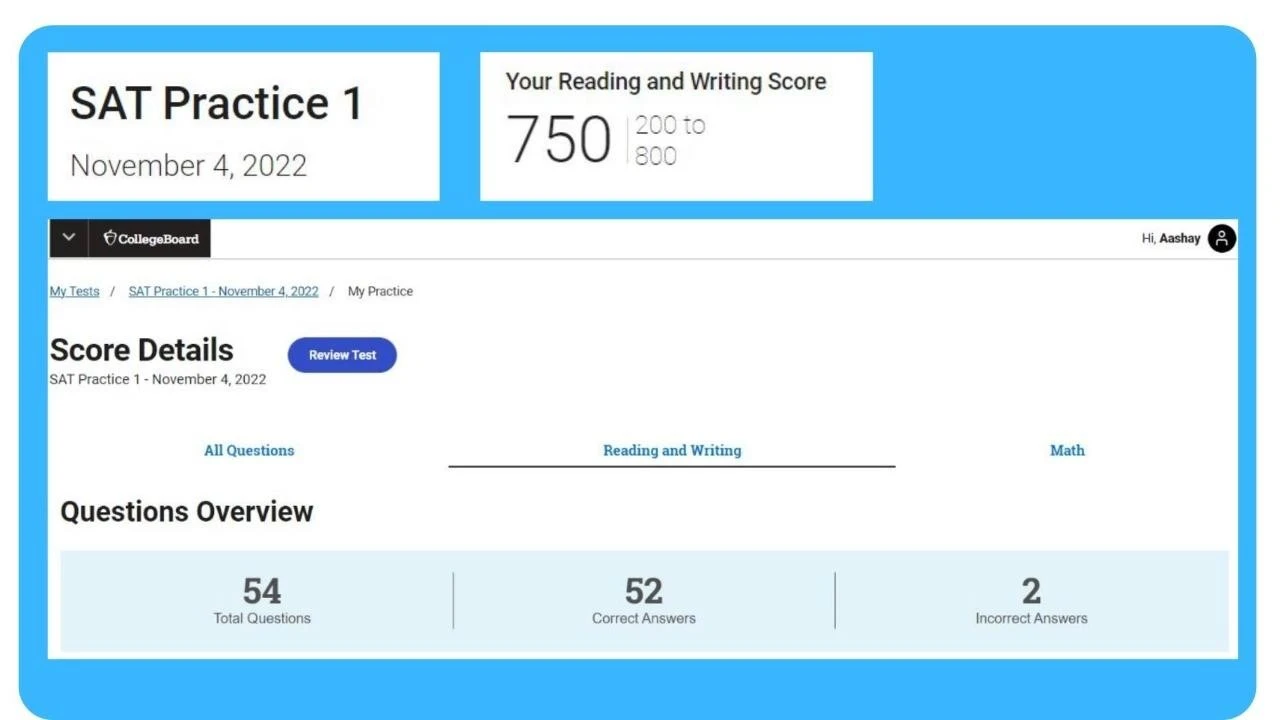Overview of the Digital SAT’s English Test
The SAT is an essential part of undergraduate applications to many colleges/universities in the US, UK, Canada, Australia, Germany, and Singapore. Several private institutions in India also accept SAT scores for admissions. International students take the SAT test to demonstrate college readiness and to boost their overall academic profile while applying to high-ranked universities. The exam is conducted by the College Board, which is a non-profit organization headquartered in New York, USA. On January 25, 2022, the College Board announced that The SAT would go Digital for international students starting March 2023. With this shift, the test will have a new look and feel.
I took a practice Digital SAT test recently and got 52 out of the 54 questions correct in the English section. For the 2 incorrect answers, 50 points were deducted from my total score as is evident here.

Let me share what I learned through this experience and shed some light on the English section of the Digital SAT. I have also listed down some tips to sail through the different challenges.
What is changing?
The new Digital SAT will have a number of new features. Firstly, it will be taken on an application called Bluebook, which must be downloaded on the device on which the student wishes to take the exam. Once the student has logged into Bluebook with his/her College Board credentials, he/she will be able to take the test. In terms of the English test, the major changes will be –
1. Shorter Time and Lesser Questions:
In the English Test, students will now have a total of 64 minutes to complete 54 questions as opposed to 100 minutes to solve 98 questions on the pen-and-paper test. This means that on average, students will have more time per question. The 54 questions are divided into two equal sections comprising of 27 questions each. Students will have 32 minutes to solve each of these sections. These sections will have questions from both the Reading Test and the Writing and Language Test of the previous version.
2. Shorter but More Texts:
On the Reading Test of pen-and-paper SAT, students were given 5 texts with about 500-700 words per passage. In addition, in the Writing and Language Test, they were presented with 4 texts with an average word count of 400 each. For the new Digital SAT, however, the word length for each text will be in the range of 25-150. Although the word count per passage is lower, students will have to read 54 separate short passages on the new Digital SAT. In other words, every question will have a separate text associated with it.
3. The 4 Core Content Domains:
The College Board has stated that the new Digital SAT will still evaluate the same skillset as the pen-and-paper version of the test. Nevertheless, as the older Reading Test and Writing & Language Test will now be merged within the 2 new sections, the focus will shift to the 4 core content domains mentioned below:
| Content Domain | Description | Question Types | Question Distribution |
| Craft and Structure | Focuses on assessing the comprehension, vocabulary, analysis, synthesis, and reasoning skills and knowledge needed to understand and use high-utility words and phrases in context, evaluate texts rhetorically, and make connections between topically related texts. | Words in Context Text Structure and Purpose Cross-Text Connections |
13-15 questions (~28% weightage) |
| Information and Ideas | Assesses comprehension, analysis, and reasoning skills and knowledge and the ability to locate, interpret, evaluate, and integrate information and ideas from texts and informational graphics (tables, bar graphs, and line graphs). | Central Ideas and Details Command of Evidence (both Textual and Quantitative) Inferences |
12-14 questions (~26% weightage) |
| Standard English Conventions | Assesses the ability to edit texts to conform to core conventions of Standard English sentence structure, usage, and punctuation. | Boundaries Form, Structure, and Sense |
11-15 questions (~26% weightage) |
| Expression of Ideas | Assesses the ability to revise texts to improve the effectiveness of written expression and to meet specific rhetorical goals. | Rhetorical Synthesis Transitions |
8-12 questions (~20% weightage) |
4. Computer-Adaptive Testing:
Perhaps the most significant change is the nature of testing. With the SAT going digital, it is going to adopt the computer-adaptive testing approach. This means that in the first of the two sections, students will encounter a mix of easy, medium, and difficult questions. Based on how they perform in this section, they will get either easier or harder questions in the next set. This will be crucial in determining the overall score as only those who get a difficult second section and score well in it will stand a chance to get to a perfect score.
What is staying the same?
In spite of these changes, the SAT will still be scored out of 1600 – the English component out of 800. The students will still have the opportunity to take a break between the English and Math sections. In terms of preparing for the English test, the basic approach would remain similar – perfecting the grammatical aspects and drawing up a comprehensive reading list. Like the pen-and-paper test, the College Board has shared free practice material for the Digital SAT. The colleges will keep using the SAT score in their admissions process in the same way as they did previously.
What are the key challenges?
As is clear from the structure of the new English component of the Digital SAT, the biggest challenge will be time management. In the pen-and-paper test, the students had to go through only 9 passages and there was an opportunity to read each text 2-3 times if need be. On the other hand, with the Digital SAT, there would be 54 short texts and the students would be required to proceed through them at a considerable pace. It can be challenging as they may not have the same level of comfort with all the texts. This also means that they will have to be extremely quick with the questions that they find relatively easy.
The students will have the ability to mark questions for review and return to them later. Although this is designed as a positive feature, marking many questions for review will lead to more problems in the test. Navigating through the questions is quite straightforward, but revisiting multiple questions will mean that students will have to spare more time for each question they have marked for review.
The table above lists the 4 core content domains. After taking a close look, it is evident that students have to be equally good at all of those. This means that if there is a weakness related to language or comprehension, it has to be identified and fixed before the students appear for the test.
Last but not the least, each wrong answer on the Digital SAT will result in more points being lost. On the pen-and-paper test, students would lose about 10 points for every incorrect response. However, the image with my scores above makes it clear that on the new Digital SAT, students would lose about 25 points for each incorrect answer, which is quite harsh.
How to achieve a high score?
As we have seen earlier, making even 1 mistake can cost students dearly on the Digital SAT. We recommend that students ensure that they wrinkle out any basic grammar-related weaknesses that may have crept into their language use. On top of this, they should create a comprehensive reading list, covering authors from different time periods. Consistent practice and analysis is a key to success in the SAT test. Students cannot take every practice test with the same approach. They must first evaluate what went wrong in their previous practice test and what can be done to improve. Only after this analysis should they appear for their next practice test.
How to practice?
It is important to practice with the right material for a perfect SAT score. As mentioned above, students can take advantage of the free resources provided by the College Board. The only issue with that is there’s not much to practice. For authentic practice material and guidance, students can take a look at Scholarly’s SAT Prep plans. They can choose from self-paced courses as well as instructor-led live classes for the Digital SAT. Scholarly’s SAT prep platform provides students with 10,000+ practice questions, 20+ Mock Tests, and 400+ Topic Worksheets.
To sum up, the new Digital SAT will bring many changes to the test, the way it is evaluated, and the way students should approach it. They should ensure that they prepare for the test the right way and should not hesitate to seek expert guidance.
About the Author:

Aashay Ghadge is an American TESOL Certified English Trainer. He has spent over 5 years teaching 4000+ students from varied cultural and educational backgrounds across China and Thailand. He also has certifications for teaching IELTS, TOEFL iBT, and PTE from exam-conducting bodies like Cambridge, IDP, ETS, and Pearson. He has been helping students succeed in these tests since 2018.
Scholarly helps ambitious international students locate the right universities and courses to pursue their education. We provide college credit courses and research papers to students that want to learn more and differentiate themselves. We help students develop and present their best version to their dream university. Our recommendations are based on the student’s field of interest, academic performance, financial resources and career plans. We provide test preparation classes from the best teachers to help improve scores and thus the prospects for admission. We also assist students with their visa and loan applications to reduce the anxiety associated with international education.
For additional questions about international education, choice of majors, university selection or admission strategies please visit the Questions section of our website.

 Previous Post
Previous Post Next Post
Next Post
